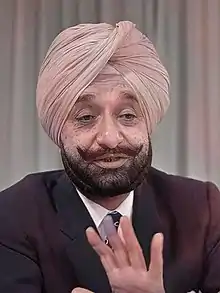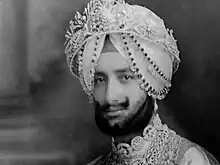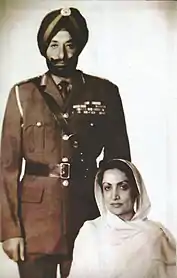Yadavindra Singh
Yadavindra Singh GCIE GBE (ⓘ) was the 9th and last ruling Maharaja of Patiala from 1938 to 1971. He was also a diplomat, sports administrator and former cricketer who played in one Test in 1934.[1][2]
Yadavindra Singh | ||||||||||||||||||||||||||||||||||||||||
|---|---|---|---|---|---|---|---|---|---|---|---|---|---|---|---|---|---|---|---|---|---|---|---|---|---|---|---|---|---|---|---|---|---|---|---|---|---|---|---|---|
 Singh in 1971 | ||||||||||||||||||||||||||||||||||||||||
| Maharaja of Patiala | ||||||||||||||||||||||||||||||||||||||||
| Reign | 23 March 1938 – 15 August 1947 | |||||||||||||||||||||||||||||||||||||||
| Predecessor | Maharaja Bhupinder Singh | |||||||||||||||||||||||||||||||||||||||
| Successor | Amarinder Singh (as titular monarch) | |||||||||||||||||||||||||||||||||||||||
| Minister of State | See list | |||||||||||||||||||||||||||||||||||||||
| Born | Patiala, Patiala State, British India | |||||||||||||||||||||||||||||||||||||||
| Died | The Hague, Netherlands | |||||||||||||||||||||||||||||||||||||||
| Maharanis | ||||||||||||||||||||||||||||||||||||||||
| Issue |
| |||||||||||||||||||||||||||||||||||||||
| Dynasty | Phulkian | |||||||||||||||||||||||||||||||||||||||
| Father | Maharaja Bhupinder Singh | |||||||||||||||||||||||||||||||||||||||
| Mother | Bakhtawar Kaur | |||||||||||||||||||||||||||||||||||||||
| Religion | Sikhism | |||||||||||||||||||||||||||||||||||||||
| Indian Ambassador to Italy | ||||||||||||||||||||||||||||||||||||||||
| In office 1965–1966 | ||||||||||||||||||||||||||||||||||||||||
| Indian Ambassador to the Netherlands | ||||||||||||||||||||||||||||||||||||||||
| In office 1971–1974 | ||||||||||||||||||||||||||||||||||||||||
| Preceded by | Jagan Nath Dharmija | |||||||||||||||||||||||||||||||||||||||
| Succeeded by | K. S. Bajpai | |||||||||||||||||||||||||||||||||||||||
| Cricket information | ||||||||||||||||||||||||||||||||||||||||
| Batting | Right-hand bat | |||||||||||||||||||||||||||||||||||||||
| Bowling | - | |||||||||||||||||||||||||||||||||||||||
| International information | ||||||||||||||||||||||||||||||||||||||||
| National side |
| |||||||||||||||||||||||||||||||||||||||
| Only Test (cap 21) | 10 February 1934 v England | |||||||||||||||||||||||||||||||||||||||
| Career statistics | ||||||||||||||||||||||||||||||||||||||||
| ||||||||||||||||||||||||||||||||||||||||
Source: ESPNcricinfo, 31 May 2020 | ||||||||||||||||||||||||||||||||||||||||
Early life and family

Born at Patiala City in Patiala State, within the British Raj (now in Punjab, India) in 1914 into a Sikh Jat family of the Sidhu clan,[3] Maharaja Yadavindra attended Aitchison College in Lahore. He served in the Patiala State Police, became its Inspector General and served in Malaya, Italy and Burma during the Second World War. In 1935, he married his first wife, Hem Prabha Devi of Saraikela State (1913–2014).
He succeeded his father, Maharaja Bhupinder Singh, as the Maharaja of Patiala on 23 March 1938 and subsequently married his second wife, Mehtab Kaur (1922–2017), in 1938. Although the stated reason for his second marriage was that it was due to his first wife being issueless, it was believed that the actual reason was the influences of Akali leaders who wanted the future Maharaja of Patiala to marry a woman from a Jat Sikh family in order to beget genuine Sikh heirs.[4]
Political career
Yadavindra served as president of the Indian Olympic Association from 1938 to 1960. He was instrumental in organizing the Asian Games. He was a noted horticulturist by passion and later served as chairman of Indian Horticulture Development Council. He was also the president of Board of Control for Cricket in India (BCCI).
Following his accession to the throne of Patiala, Yadavindra pursued a political and diplomatic career, serving as chancellor of the Chamber of Princes from 1943 to 1944. In 1947, when India gained independence, he was the pro-chancellor of the Chamber of Princes. At a special session he said "After centuries time has come when India has gained independence from foreign rule and it's the time when we all (princely states) should unite for our motherland" and persuaded many other rulers to join India.
Partition (1947)
During the Partition of India numerous pogroms occurred in and around the princely state of Patiala.[5] In several cases, organized bands of Sikhs were responsible for atrocities. The late Harkishan Singh Surjeet, of the Communist Party of India (Marxist), witnessed the events and claimed in an interview: 'The communal attacks on the minorities were definitely planned. I know more about the persons involved in the eastern wing because I was there. I saw those dreadful acts with my own eyes. In that conspiracy, the Maharaja of Patiala was involved. The idea was that if the Muslims were driven out.' The attacks on Sikhs and Hindus in March 1947 in Rawalpindi are regarded as one of the major crimes that triggered off others. Nehru believed the Maharaja had sought to ethnically cleanse the territory of Muslims as part of this effort. Maharajas of Patiala and Faridkot, and Yadavindra Singh is quoted as having said "We won't leave a Muslim here" at a party with British officers.[6] The Foreign Minister of Patiala, Sardar Bari Ram Sharma issued a denial stating "I definitely assert that no Patiala soldier has associated himself with or has been involved in any killings in any part of the East Punjab."[7]
He agreed to the incorporation of the princely state into India on 5 May 1948. He was Rajpramukh of the new Indian state of Patiala and East Punjab States Union until it was merged with Punjab in 1956.
Donation
In 1956, Sir Yadavindra Singh donated the Anand Bhawan, a 150 bigha palace, to the Government of Punjab (before the creation of Himachal) for a holiday home for poor children, which was later leased out to Baba Ramdev for his Patanjali Trust.
He founded Yadavindra Public School. Lal Bagh Palace, the building in which Yadavindra Public School is housed was donated by Sir Yadavindra Singh. The Yadavindra Public School, Mohali is also named after him and was established by the members of his family.
Later life and death
He continued his career from 1956 onwards, serving as Indian delegate to the United Nations General Assembly from 1956 to 1957 and to UNESCO in 1958. He also headed the Indian delegation to the FAO on and off during 1959–1969. Sir Yadavindra served as Indian Ambassador to Italy (1965–1966) and as Indian Ambassador to the Netherlands from 1971 until 17 June 1974, when he died suddenly in office at The Hague from heart failure, age 60. On specific instructions of Indira Gandhi, he was cremated with full state honours.
He was succeeded as family head by his son Captain Amarinder Singh, who is a politician with the formerly Congress now in Bhartiya Janata Party and who served as Chief Minister of the Indian State of Punjab from 2002 to 2007 and again starting in 2017 to 2021. His daughter, Heminder Kaur, was married to K. Natwar Singh, the former external affairs minister of India.
Titles
- 1913-1935: Sri Yuvaraja Yadavindra Singh Sahib-ji
- 1935-1938: Lieutenant Sri Yuvaraja Yadavindra Singh Sahib-ji
- 1938-1939: Lieutenant His Highness Farzand-i-Khas-i-Daulat-i-Inglishia, Mansur-i-Zaman, Amir ul-Umara, Maharajadhiraja Raj Rajeshwar, 108 Sri Maharaja-i-Rajgan, Maharaja Yadavindra Singh, Mahendra Bahadur, Yadu Vansha Vatans Bhatti Kul Bushan, Maharaja of Patiala
- 1939-1942: Captain His Highness Farzand-i-Khas-i-Daulat-i-Inglishia, Mansur-i-Zaman, Amir ul-Umara, Maharajadhiraja Raj Rajeshwar, 108 Sri Maharaja-i-Rajgan, Maharaja Yadavindra Singh, Mahendra Bahadur, Yadu Vansha Vatans Bhatti Kul Bushan, Maharaja of Patiala
- 1942-1944: Major His Highness Farzand-i-Khas-i-Daulat-i-Inglishia, Mansur-i-Zaman, Amir ul-Umara, Maharajadhiraja Raj Rajeshwar, 108 Sri Maharaja-i-Rajgan, Maharaja Sir Yadavindra Singh, Mahendra Bahadur, Yadu Vansha Vatans Bhatti Kul Bushan, Maharaja of Patiala, GBE
- 1944-1945: Lieutenant-Colonel His Highness Farzand-i-Khas-i-Daulat-i-Inglishia, Mansur-i-Zaman, Amir ul-Umara, Maharajadhiraja Raj Rajeshwar, 108 Sri Maharaja-i-Rajgan, Maharaja Sir Yadavindra Singh, Mahendra Bahadur, Yadu Vansha Vatans Bhatti Kul Bushan, Maharaja of Patiala, GBE
- 1945-1946: Major-General His Highness Farzand-i-Khas-i-Daulat-i-Inglishia, Mansur-i-Zaman, Amir ul-Umara, Maharajadhiraja Raj Rajeshwar, 108 Sri Maharaja-i-Rajgan, Maharaja Sir Yadavindra Singh, Mahendra Bahadur, Yadu Vansha Vatans Bhatti Kul Bushan, Maharaja of Patiala, GBE
- 1946-1971: Lieutenant-General His Highness Farzand-i-Khas-i-Daulat-i-Inglishia, Mansur-i-Zaman, Amir ul-Umara, Maharajadhiraja Raj Rajeshwar, 108 Sri Maharaja-i-Rajgan, Maharaja Sir Yadavindra Singh, Mahendra Bahadur, Yadu Vansha Vatans Bhatti Kul Bushan, Maharaja of Patiala, GCIE, GBE
- 1971-1974: Lieutenant-General Sir Yadavindra Singh, GCIE, GBE
Honours
(ribbon bar, as it would look today; UK decorations only)
![]()
![]()
![]()
![]()
![]()
![]()
![]()
![]()
![]()
![]()
![]()
- King George V Silver Jubilee Medal-1935
- King George VI Coronation Medal-1937
- Knight Grand Cross of the Order of the British Empire (GBE)-1942
- 1939-1945 Star-1945
- Burma Star-1945
- Africa Star-1945
- Italy Star-1945
- British War Medal-1945
- India Service Medal-1945
- Knight Grand Commander of the Order of the Indian Empire (GCIE)-1946
- Indian Independence Medal-1947
- Grand Cross of the Romanian order
- Grand Cross of the Order of Merit of the Republic of Italy-1966
Gallery


References
- "The Greatest: One Test Wonders". International Cricket Council. Retrieved 19 April 2018.
- "Yadavindra Singh". ESPNcricinfo. Retrieved 31 May 2020.
- Balfour, Edward (1885). The Cyclopædia of India and of Eastern and Southern Asia: Commercial, Industrial and Scientific, Products of the Mineral, Vegetable, and Animal Kingdoms, Useful Arts and Manufactures. B. Quaritch.
- Singh, K.C. (3 August 2017). "Tales from two Punjabs". tribuneindia.com.
- Mustafa Janjua, Haroon (7 January 2014). "Daily Times – Unheard cries: atrocities in Patiala, 1947".
- Hajari, Nisid (15 June 2015). Midnight's Furies: The Deadly Legacy of India's Partition. ISBN 9781445648095.
- Singh, Ganda (1960). "A Diary of the Partition Days – 1947". Journal of Indian History. XXXV (Part I, No. 112): 270.
